Those Who Left Marks on the Princes' Islands
- Details
- Created on 19 February 2013
- Last Updated on 01 April 2013
Eirene; Byzantium's First and Only Empress Was Exiled to Büyükada
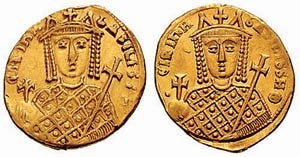 The empress Irene was the first and only female sovereign of Byzantium but she had been dethroned and arrested following a palace coup. Then, 1209 years ago, escorted by armed guards, she was taken to the convent on Büyükada.?Irene was locked away in a cell. As she?gazed from the window facing Sedefadası (Terebinthos), she felt the irony ofher situation. She was the one who had commissioned theconstruction of this convent, but now she was imprisoned in it. Sometime later, she was secretly exiled to Midilli Island (Lesbos).Irene did not survive for long.
The empress Irene was the first and only female sovereign of Byzantium but she had been dethroned and arrested following a palace coup. Then, 1209 years ago, escorted by armed guards, she was taken to the convent on Büyükada.?Irene was locked away in a cell. As she?gazed from the window facing Sedefadası (Terebinthos), she felt the irony ofher situation. She was the one who had commissioned theconstruction of this convent, but now she was imprisoned in it. Sometime later, she was secretly exiled to Midilli Island (Lesbos).Irene did not survive for long.
Her last wish was, “Lay my body to rest in the Saint Nicholas Chapel to the left of the Virgin Mary Church at the monastery I built with my sorrowful and suffering heart on Prinkipo Island (Büyükada) in the sight of God.” And that is what they did.
M. Kemal Atatürk
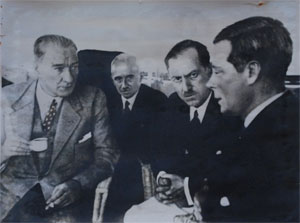 Atatürk visited Büyükada’yı ve Anadolu Club frequently. He met important state persons. Notable guests have included Atatürk and Ismet Inönü as well as foreign heads of state: Elefterios Venizelos, Prime Minister of Greece (1924); King Amanullah Han of Afghanistan (1930); King Carol of Romania and Madame Lupescu (1933); General Metaxas, the Greek dictator (1936); Shah Riza Pahlavi of Iran (1964); and Nikolau Ceausescu, the Romanian dictator (1976). When Atatürk visited the club he stayed in Room 25, which is preserved as it was in his time. In the garden of the club there is a monument to Atatürk, dedicated in 1981 to mark the centenary of his birth. The club cannot be visited, but one can observe the beautiful buildings and grounds from the gateway.
Atatürk visited Büyükada’yı ve Anadolu Club frequently. He met important state persons. Notable guests have included Atatürk and Ismet Inönü as well as foreign heads of state: Elefterios Venizelos, Prime Minister of Greece (1924); King Amanullah Han of Afghanistan (1930); King Carol of Romania and Madame Lupescu (1933); General Metaxas, the Greek dictator (1936); Shah Riza Pahlavi of Iran (1964); and Nikolau Ceausescu, the Romanian dictator (1976). When Atatürk visited the club he stayed in Room 25, which is preserved as it was in his time. In the garden of the club there is a monument to Atatürk, dedicated in 1981 to mark the centenary of his birth. The club cannot be visited, but one can observe the beautiful buildings and grounds from the gateway.
Fethi Okyar
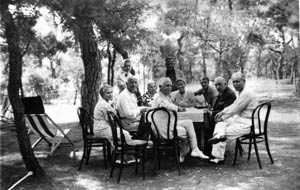 Ali Fethi Okyar had been a close friend of Mustafa Kemal Atatürk since their childhood. Fethi Okyar- soldier, diplomat, MP and minister- became the leader of the opposition the Free Republic Party, established in 1930 with Atatürk’s approval and support. But in the same year, finding it impossible to continue the party, he retreated to his house on Büyükada.
Ali Fethi Okyar had been a close friend of Mustafa Kemal Atatürk since their childhood. Fethi Okyar- soldier, diplomat, MP and minister- became the leader of the opposition the Free Republic Party, established in 1930 with Atatürk’s approval and support. But in the same year, finding it impossible to continue the party, he retreated to his house on Büyükada.
İsmet İnönü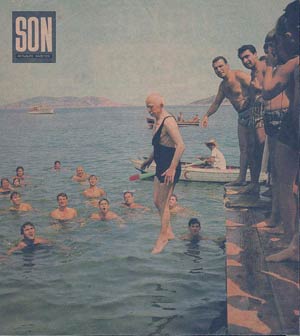
Ismet Inonu, first Turkish Prime Minister and later President of the Turkish Republic. Ismet Inönu, first rented the house originally known as the Mavromatakis Köşku on Heybeliada, as a summer home in 1924, when he recuperated there after an illness. The Inönus bought the house in 1934 for 9,500 liras, with new furniture presented to them as a gift by Atatürk. Eventually the family decided to have the house preserved as a museum under the Inönu Foundation, restored just as it was when Ismet Paşa moved there in 1937.
Yesari Asım Arsoy
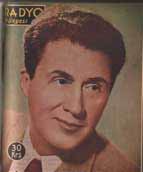 "Biz Heybeli’de her gece mehtaba çıkardık" In a little park next to the Naval High School there is a statue of Yesari Asim Arsoy (1896-1992), famous as the composer of a song celebrating Heybeli
"Biz Heybeli’de her gece mehtaba çıkardık" In a little park next to the Naval High School there is a statue of Yesari Asim Arsoy (1896-1992), famous as the composer of a song celebrating Heybeli
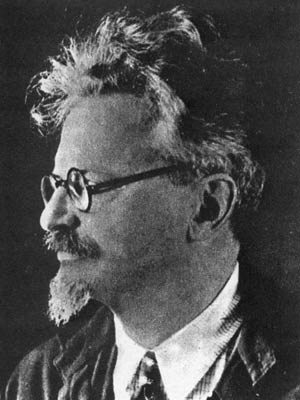
Lev Trotsky
Lev Davidovich Trotsky, one of the leaders of the Soviet Revolution, came to Istanbul when forced into exile by Stalin in 1929 and spent most of his four-year stay in Istanbul on Büyükada.
Trotsky left Büyükada on 17 July 1933, never to return. Despite his isolation on the island he seems to have enjoyed his exile there, as evidenced by the last entry he made in his notebook on the day he departed: "It has been four and one-half years. I have the strange feeling of having my feet firmly planted on Büyükada."
Label on the Famous Kulüp Rakısı
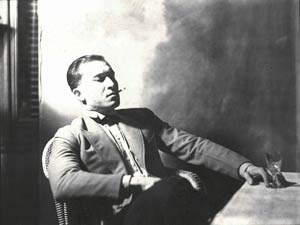
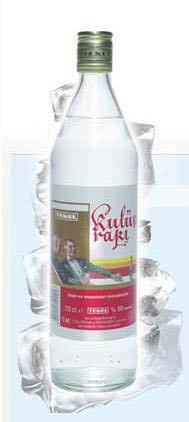 Ihap Hulusi Görey, a graphic designer and painter, and Fazıl Ahmet Aykaç, a poet, author, teacher and MP, both from Kınalıada, were close friends. They got together from time to time on their island and sometimes at the Büyükada Anatolian Club.
Ihap Hulusi Görey, a graphic designer and painter, and Fazıl Ahmet Aykaç, a poet, author, teacher and MP, both from Kınalıada, were close friends. They got together from time to time on their island and sometimes at the Büyükada Anatolian Club.
His label for the famous Kulüp Rakısı--the label still used today--shows two very stylish, handsome gentlemen drinking raki. They are said to be Fazıl Ahmet Aykaç and Ihap Hulusi himself, pictured drinking at the Anatolian Club. With this label, designed in 1932, the famous artist immortalised their friendship.
Lefter Küçükandonyadis
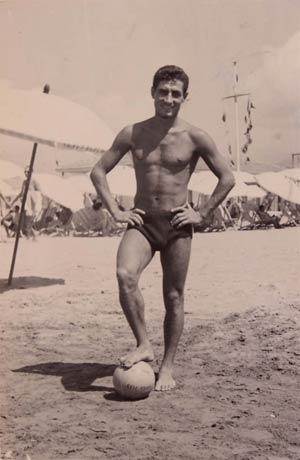 Lefter Küçükandonyadis played first for Taksimspor. After his military service, at age 21, he signed with Fenerbahçe, where he scored 407 goals in 605 games. He was the first footballer to wear the national jersey 50 times, scoring 22 goals in international games. Lefter, still a football legend, is now 86 years old and lives on Büyükada.
Lefter Küçükandonyadis played first for Taksimspor. After his military service, at age 21, he signed with Fenerbahçe, where he scored 407 goals in 605 games. He was the first footballer to wear the national jersey 50 times, scoring 22 goals in international games. Lefter, still a football legend, is now 86 years old and lives on Büyükada.
Mina Urgan
“Trotsky used to live in a residence on Nizam Street at Büyükada, with a garden?that stretched all the way to the shore. He never walked about in the streets, but went fishing on his boat almost every day. One day, when I was swimming offshore I recognized Trotsky’s boat. We were be able to identify this boat from afar, because there were two Russian bodyguards on the bow and stern.?In the middle sat the Greek fisherman?that pulled the oars and Trotsky holding?his fishhook. I quickly swam towards the?boat and held onto the side and practically came face to face with Trotsky. One of the bodyguards said ‘Go, go.’ (Actually he said ‘Go, go’ with a Russian accent.) I wanted to use my fatigue as an excuse to hold on so I could watch Trotsky a bit longer.”
Mina Urgan,
The Memories of a Dinosaur
Ziya Gökalp
Yahya Kemal persuaded his friend, Ziya Gökalp (1876-1924), to move to Büyükada. After Gökalp came, Turkish nationalist intellectuals such as Ahmet Ağaoğlu, Hamdullah Suphi, Celal Sahir, Necmettin Sadık and Fuat Köprülü began to gather on Büyükada.?Gökalp’s illness worsened in 1924 he was taken to Büyükada from Nişantaşı. While he was ill on the island, he edited his book, Türk Medeniyet Tarihi.
He resided at: Fatma Hurrem House, Albayrak Sokağı (Maden) No:17?. Rotenberg Mansion, Çankaya Caddesi Albayrak Sokak (Maden) No: 6
Melih Cevdet Anday
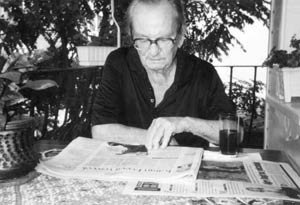 Melih Cevdet Anday, one of the most important poets in Turkish literature, penned the often-quoted line about the island, “Ada vapuru yandan çarklı...”. Anday was one of the founders of the Garip movement of poetry and the philosophical poetic movement. UNESCO considered him to be a writer as important as Cervantes, Dante and Tolstoy. He wrote articles and essays in newspapers under both his real name and penname and also did translations. His poems, essays, criticisms, plays and novels received many awards. He spent the last years of his life on Büyükada and he is buried on the island.
Melih Cevdet Anday, one of the most important poets in Turkish literature, penned the often-quoted line about the island, “Ada vapuru yandan çarklı...”. Anday was one of the founders of the Garip movement of poetry and the philosophical poetic movement. UNESCO considered him to be a writer as important as Cervantes, Dante and Tolstoy. He wrote articles and essays in newspapers under both his real name and penname and also did translations. His poems, essays, criticisms, plays and novels received many awards. He spent the last years of his life on Büyükada and he is buried on the island.
The Fisherman of Halicarnassus
Halikarnas Balıkçısı (1890-1973), whose real name was Cevat Şaki Kabaağaçlı, completed his primary education on Büyükada. While he attended Robert College, he spent his summers at Rosola Mansion on Büyükada, together with his large family.
Yahya Kemal Beyatlı
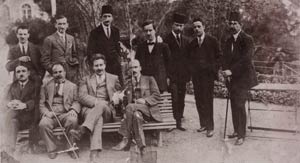 Yahya Kemal Beyatlı (1884-1958) came to Büyükada in 1913 upon the recommendation of Tahsin Nahid and stayed in a fine, pleasant room on the top floor of the Savoy Hotel, with a window facing the street . He also stayed at the Splendid Hotel for a short period. The following year, when he returned to Büyükada, he rented a mansion with Yakup Kadri on Azaryan Yokuşu, with a sea view, two bedrooms, a kitchen at the back and a maid’s room.
Yahya Kemal Beyatlı (1884-1958) came to Büyükada in 1913 upon the recommendation of Tahsin Nahid and stayed in a fine, pleasant room on the top floor of the Savoy Hotel, with a window facing the street . He also stayed at the Splendid Hotel for a short period. The following year, when he returned to Büyükada, he rented a mansion with Yakup Kadri on Azaryan Yokuşu, with a sea view, two bedrooms, a kitchen at the back and a maid’s room.
In addition to his duties at Darülfünun (University), Kemal served as a history teacher at the Heybeliada Naval Academy. Nâzım Hikmet and Necip Fazıl Kısakürek were students of Kemal’s during this period.
Nurullah Ataç
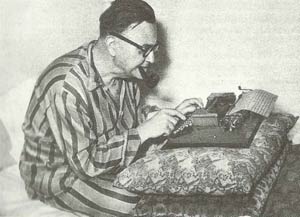 Nurullah Ataç (1898-1957), one of the limited number of authors who only wrote criticisms and essays during the Republic period, was an admirer of the Islands. To him, Büyükada was Istanbul. He rarely went to the city. He complained about not being able to write in Istanbul. Shortly after his daughter Meral was born, Nurullah Ataç settled on Büyükada with his family. Meral Ataç Tolluoğlu sincerely describes her memories of her father and Büyükada in her book, Babam Nurullah Ataç:
Nurullah Ataç (1898-1957), one of the limited number of authors who only wrote criticisms and essays during the Republic period, was an admirer of the Islands. To him, Büyükada was Istanbul. He rarely went to the city. He complained about not being able to write in Istanbul. Shortly after his daughter Meral was born, Nurullah Ataç settled on Büyükada with his family. Meral Ataç Tolluoğlu sincerely describes her memories of her father and Büyükada in her book, Babam Nurullah Ataç:
“In terms of nature, the island is far more beautiful in winter than summer. The inhabitants of the island are like kith and kin. Everybody knows each other, greet each other and ask after each other. To live in such a place gives people both happiness and trust. Also, my uncle and his family live here both in summer and winter. After my father and mother thought about it, they decided to settle on the Island again after they moved.”
From Babam Nurullah Ataç
He resided at: Ataç House Lonca Sokağı No:24
Reşat Nuri Güntekin
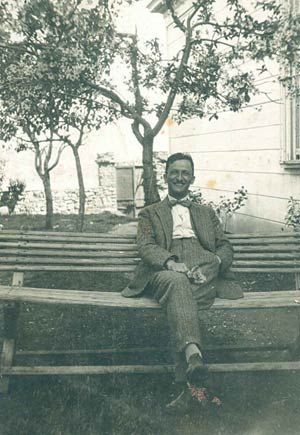 Reşat Nuri Güntekin (1889-1956), the author of Çalıkuşu, one of the most widely read novels in Turkish literature, settled on Büyükada in the 1930’s with his family because he liked living in quiet places. He hosted his relatives more often than his writer friends; he hosted dinner for them, as they played on the swings in the garden. His daughter, Ela Güntekin, who came to Büyükada when she was only a few months old, spent time with her father as they walked and chatted. For many years, the family spent their summers on the island.
Reşat Nuri Güntekin (1889-1956), the author of Çalıkuşu, one of the most widely read novels in Turkish literature, settled on Büyükada in the 1930’s with his family because he liked living in quiet places. He hosted his relatives more often than his writer friends; he hosted dinner for them, as they played on the swings in the garden. His daughter, Ela Güntekin, who came to Büyükada when she was only a few months old, spent time with her father as they walked and chatted. For many years, the family spent their summers on the island.
His novel, Akşam Güneşi, expresses his feelings about Büyükada.
Büyükada, House of Reşat Nuri Güntekin, Museum of the Princes’ Islands Archive
Hüseyin Rahmi Gürpınar
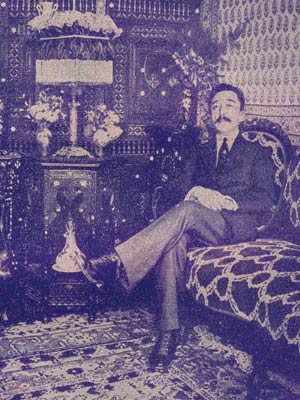 Hüseyin Rahmi Gürpınar (1864-1944) lived in a rental house for 10 years in the 1900’s. He bought land from Hıdiv Abbas Paşa and built the Gürpınar Mansion, where he lived until his death. The three-storied mansion on Heybeliada looks towards Burgazada, and from the sea, three sides of the house can be seen, far from town, high up a steep slope in a forested area. He is buried here.
Hüseyin Rahmi Gürpınar (1864-1944) lived in a rental house for 10 years in the 1900’s. He bought land from Hıdiv Abbas Paşa and built the Gürpınar Mansion, where he lived until his death. The three-storied mansion on Heybeliada looks towards Burgazada, and from the sea, three sides of the house can be seen, far from town, high up a steep slope in a forested area. He is buried here.
Hüseyin Rahmi describes his life on Heybeliada in Kokotlar Mektebi and mentions the island in Sevda Peşinde and Tebessüm-i Elem
He resided at: Gürpınar Mansion, Demirtaş Sokağı No: 19
Aziz Nesin
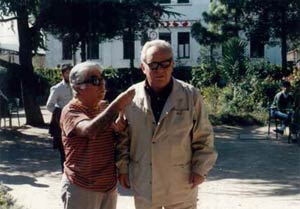 Aziz Nesin (1915-1995) is one of the writers born on the Islands. Nesin lived on Heybeli until he was 10 years old and wrote about the Heybeli of his childhood and the residents in a lively and detailed manner in Böyle Gelmiş Böyle Gitmez.
Aziz Nesin (1915-1995) is one of the writers born on the Islands. Nesin lived on Heybeli until he was 10 years old and wrote about the Heybeli of his childhood and the residents in a lively and detailed manner in Böyle Gelmiş Böyle Gitmez.
“There was only one mosque in Heybeliada: (...) The muezzin of the islands mosque Feyyaz had a serious speech defect, he stammered. He used to talk with great difficulty. But the voice of this stutterer was really beautiful. And he never stammered when he was reciting the call for prayers or chanting the Prophet Mohammed’s nativity hymn. (...) Briefly, we had to discover means to live cheap and find ways to live on a very small amount of money. There were cisterns in most of the houses, because there were no water resources on the island. We did not have a reservoir in our small house. And we could not get water from the peddling watermen who stacked water on to back of their donkeys. Because we did not want to spend money. Me and my sister – but mostly my sister – used to carry water from the fountain at the port side area in a copper churn.”
From Istanbul Boy: The Autobiography of Aziz Nesin.
Zeyyat Selimoğlu
 When mentioning Heybeliada, Zeyyat Selimoğlu (1922-2000) is one of the names that immediately come to mind. Selimoğlu translated many books into Turkish, mostly dealing with ships and the different lives of people who live/work on ships. The book Direğin Tepesinde Bir Adam attracted much attention when it was first published. All of his stories about the sea are collected in the book Gemi Adamları.
When mentioning Heybeliada, Zeyyat Selimoğlu (1922-2000) is one of the names that immediately come to mind. Selimoğlu translated many books into Turkish, mostly dealing with ships and the different lives of people who live/work on ships. The book Direğin Tepesinde Bir Adam attracted much attention when it was first published. All of his stories about the sea are collected in the book Gemi Adamları.
Ahmet Rasim
 Ahmet Rasim (1865-1932) settled on Heybeliada after living in Kadıköy and he spent the last days of his life here. He wrote about the islands in his quick and extremely entertaining style.
Ahmet Rasim (1865-1932) settled on Heybeliada after living in Kadıköy and he spent the last days of his life here. He wrote about the islands in his quick and extremely entertaining style.
Kitabe-i Gam is Rasim’s letter novel written for a beautiful woman whom he knew and loved on the Island.
He resided at: Ahmet Rasim House, Heybeliada, Hüseyin Rahmi Sokağı No: 25/1
Sait Faik Abasıyanık
 Sait Faik Abasıyanık (1906-1954) wrote about the Islands, the fishermen and the fish and is identified with Burgazada. He spent most of the last ten years of his life in the mansion at 15 Çayır Sokak.?The mansion was converted into a museum upon the will of his mother, Makbule Abasıyanık, and the Sait Faik Abasıyanık Museum was opened by the “Burgazadası’nı Güzelleştirme Derneği (The Beautification of Burgazadası Association)” on 22 August 1959. The maintenance and restoration responsibilities of the museum are met by the Darüşşafaka Cemiyeti (Darüşşafaka Association).
Sait Faik Abasıyanık (1906-1954) wrote about the Islands, the fishermen and the fish and is identified with Burgazada. He spent most of the last ten years of his life in the mansion at 15 Çayır Sokak.?The mansion was converted into a museum upon the will of his mother, Makbule Abasıyanık, and the Sait Faik Abasıyanık Museum was opened by the “Burgazadası’nı Güzelleştirme Derneği (The Beautification of Burgazadası Association)” on 22 August 1959. The maintenance and restoration responsibilities of the museum are met by the Darüşşafaka Cemiyeti (Darüşşafaka Association).
Sait Faik and Burgazada are inseparable. One will always be associated with the other and one is incomplete without the other.
He resided at: Sait Faik House, Çayır Sokağı No: 15
Halide Edip Adıvar
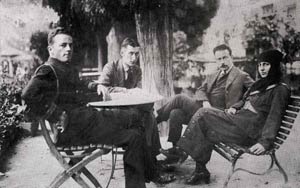 Halide Edip Adıvar (1884-1964), one of the most important writers in Turkish literature, is among those who settled on Burgazada to escape the noise of Istanbul. Her home, Zafiriadis House, with a rose garden and covered by wisteria, held a special place in her heart.
Halide Edip Adıvar (1884-1964), one of the most important writers in Turkish literature, is among those who settled on Burgazada to escape the noise of Istanbul. Her home, Zafiriadis House, with a rose garden and covered by wisteria, held a special place in her heart.
Some parts her novel, Raik’in Annesi, are set on Burgaz. She resided at: Zafiriadis House, Mehtap Sokağı No: 43
Fazıl Ahmet Aykaç
 Fazıl Ahmet Aykaç (1884-1967), whose humor and witty conversations are often quoted, is a symbol of Kınalıada. He brought important innovations to the fields of humour and poetry. He imitated many of the famous poets and poems of the period, which made him a much talked about figure.
Fazıl Ahmet Aykaç (1884-1967), whose humor and witty conversations are often quoted, is a symbol of Kınalıada. He brought important innovations to the fields of humour and poetry. He imitated many of the famous poets and poems of the period, which made him a much talked about figure.
He hosted many of his friends at his house on Kınalıada. İhap Hulusi memorialized their friendship and their conversations in the raki label he drew for Kulüp Rakısı. Naşide Görey, İhap Hulusi’s wife, tells the story of the creation of the label:
“For that Tekel raki, he developed compositions in his mind, drew sketches, tried a few models, but he was not satisfied. Meanwhile, his close friend Fazıl Ahmet Aykaç was watching him. İlhap Bey turned and said; “Fazıl, come and sit here!’ and he came and sat before him. Thus, that famous label of Kulüp Rakısı was created and has been used since that day for over half a century.”
He resided at:?. Civanyan House, Çandarlı Sokağı No: 9?. Ağasi House, Fazıl Ahmet Aykaç Caddesi No: 23
Zabel Asadur
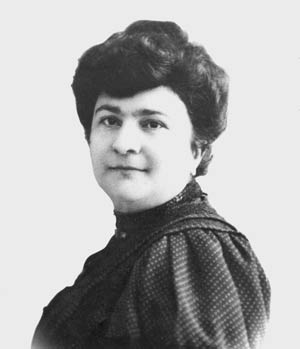 Lawyer and writer Hrand Asadur (1862-1928) and his well-known writer and poet wife, Zabel Asadur (1863-1924, nee Hancıyan), lived in a four-storied wooden house on Kınalıada known as the Derunyan house.
Lawyer and writer Hrand Asadur (1862-1928) and his well-known writer and poet wife, Zabel Asadur (1863-1924, nee Hancıyan), lived in a four-storied wooden house on Kınalıada known as the Derunyan house.
Zabel Asadur, whose goal when she was sixteen was to open schools and orphanages for the education and training of Armenian girls in Anatolia, established “Azkanıver Hayuhyats Ingerutyun” (Nationalist Armenian Women’s Association) and wrote about the problems of women in her articles published?in Masis magazine under the penname “Sibil”. She devoted herself to the liberalization of women. Asadur, who wrote for periodicals in Armenian and translated from French, also served at the Esayan and Getronogan schools as an Armenian teacher.
Zahrad
 Zahrad, whose real name was Zareh Yaldızcıyan (1924-February 21, 2007), lived on Kınalıada for many years. His first book of poetry, Büyük Şehir, was published in 1960 and translated into twenty-five languages. The poetry of this globally known poet were translated into Turkish by caricaturist, Ohannes Şaşkal and published in three anthologies: Yağ Damlası, Yapracığı Gören Balık, Işığını Söndürme.
Zahrad, whose real name was Zareh Yaldızcıyan (1924-February 21, 2007), lived on Kınalıada for many years. His first book of poetry, Büyük Şehir, was published in 1960 and translated into twenty-five languages. The poetry of this globally known poet were translated into Turkish by caricaturist, Ohannes Şaşkal and published in three anthologies: Yağ Damlası, Yapracığı Gören Balık, Işığını Söndürme.
For Zahrad, who put forward the feeling of space in his poems, Istanbul was always the island.
Yakup Kadri Karaosmanoğlu
“We were endowed with the opportunity to spend the most beautiful, most enthusiastic and the merriest of those days in Büyükada owing to the hospitality of our friends Tahsin Nahit and his wife. I said ‘Tahsin Nahit and his wife’s hospitality’. Because their house at Maden became a meeting place for us and a center of attraction. Tahsin Nahit was above all known as the poet of the Islands, island pines and island fullmoons. His wife, on the other hand was born and raised in Büyükada and I can freely say that it was this couple who taught us the beauty of the island, and also who made us love it.”
Yakup Kadri Karaosmanoğlu,
Memoirs of Youth and Literature


 Princes' Islands
Princes' Islands 